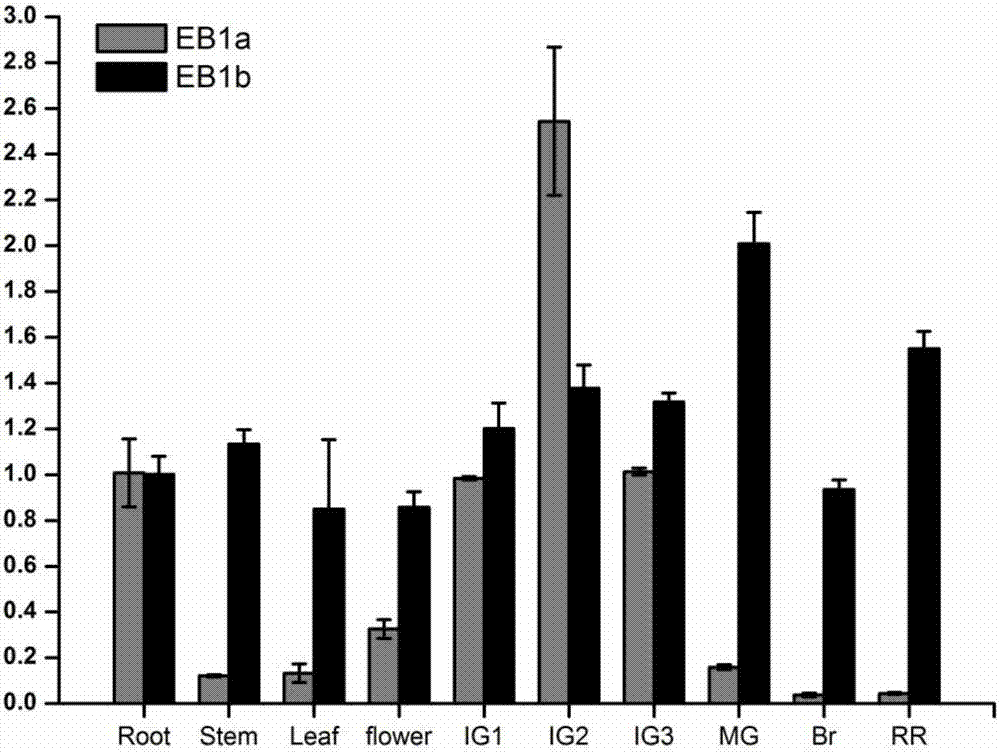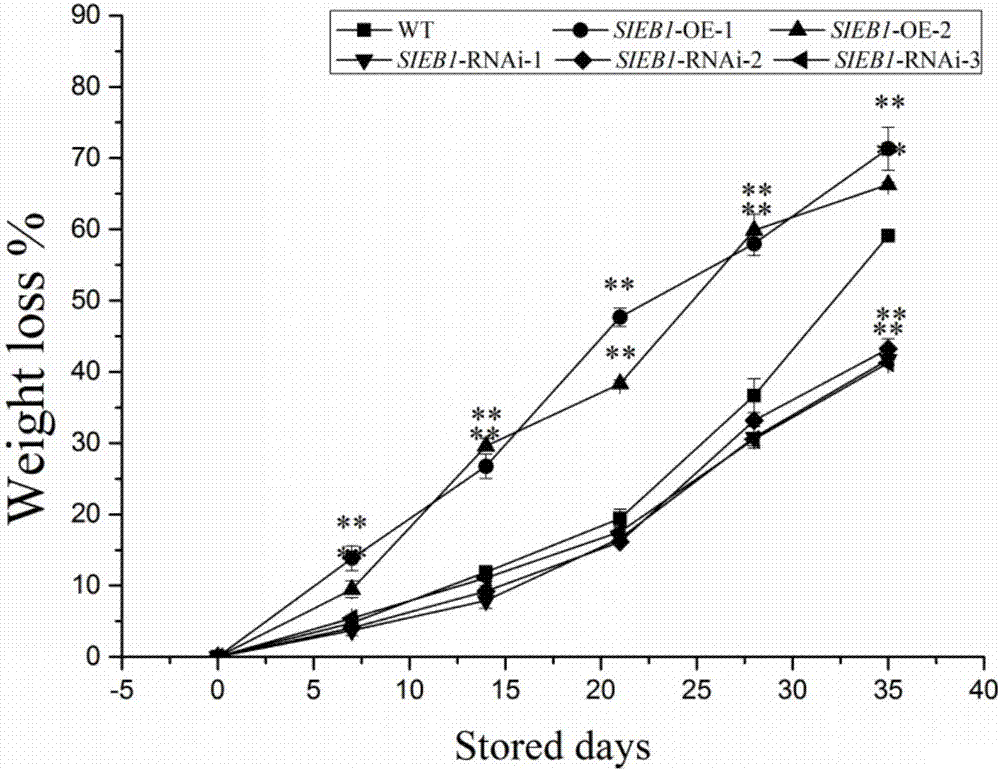Novel method for prolonging shelf life of tomato fruit by utilizing genetic engineering technology
A genetic engineering and shelf life technology, applied in genetic engineering, recombinant DNA technology, botanical equipment and methods, etc., can solve the problem of not significantly delaying fruit ripening and softening, affecting fruit nutrients, active ingredients and flavor, unsuitable Production application and other issues, to achieve the effect of large application value and extended shelf life
- Summary
- Abstract
- Description
- Claims
- Application Information
AI Technical Summary
Problems solved by technology
Method used
Image
Examples
Embodiment 1
[0033] Example 1: cDNA cloning and spatiotemporal expression analysis of tomato S1EB1 gene
[0034] 1. SlEB1 gene sequence analysis
[0035] Search the tomato genome database, tomato has two AtEB1 homologous genes, namely SlEB1a (Solyc03g116370) and SlEB1b (Solyc02g092950); the DNA sequence of SlEB1a is shown in SEQ ID NO 1; the DNA sequence of SlEB1b is shown in SEQ ID NO 2.
[0036] 2. Extraction of tomato total RNA
[0037] (1) Take an equal amount of tomato roots, stems, leaves, flowers and fruits at different development stages, divide them into groups, and grind them fully in liquid nitrogen; then add TRIzol Reagent (1mL TRIzol Reagent per 100mg sample), and fully After mixing, place at room temperature for 5 min.
[0038] Wherein, the different developmental stages are: IG1 (Immature Green1, immature green stage I), IG2 (Immature Green1, immature green stage II), IG3 (Immature Green1, immature green stage III), MG (MatureGreen, mature green stage ), Br (Breaker, brea...
Embodiment 2
[0073] Example 2: Construction of the overexpression vector of the SlEB1a gene and the RNAi vector of the SlEB1a / SlEB1b gene
[0074] In order to verify the role of SlEB1a gene, an overexpression vector of SlEB1a gene was constructed; at the same time, considering that SlEB1a and SlEB1b genes may have functional redundancy, an RNAi vector of SlEB1a / SlEB1b gene was constructed to simultaneously silence SlEB1a and SlEB1b genes.
[0075] In the following sequence, the underlined sequence indicates the restriction endonuclease cutting site in the brackets after the sequence. If there are multiple restriction enzymes in the brackets, the restriction endonuclease site represented by the sequence is the same as the restriction endonuclease in the brackets. Enzymes correspond one to one in sequence; The sequence in is the linker sequence.
[0076] 1. Construction of SlEB1a overexpression vector
[0077] In order to facilitate subsequent detection, the GFP gene was connected to the ...
Embodiment 3
[0120] Embodiment three: Agrobacterium-mediated genetic transformation transforms tomato variety AC +
[0121] The overall idea is: transform the overexpression vector pBI121:GFP-SlEB1a of the SlEB1a gene and the RNAi vector pBI121:SlEB1a / SlEB1bRi of the SlEB1a / SlEB1b gene into Agrobacterium EHA105 respectively, and then transform the tomato variety AC + , Tomato AC + Seeds were preserved in our laboratory. Specific steps are as follows:
[0122] 1. Agrobacterium transformation
[0123] On ice, add 10 μL of plasmid to Agrobacterium EHA105 competent cells, mix gently, and place for 40 minutes; liquid nitrogen cold shock for 1 minute; quickly put in a 37°C water bath for 5 minutes; place on ice for 2 minutes; LB culture solution (5g / LYeast extract, 10g / L NaCl, 10g / L tryptone) 600μL, 170rpm, 28℃ shaking culture for 4h; Spread evenly on LB solid medium containing 50mg / L kanamycin and 100mg / L rifampicin; incubate the plate upside down at 28°C for 2 days, and the grown colonies...
PUM
 Login to View More
Login to View More Abstract
Description
Claims
Application Information
 Login to View More
Login to View More - R&D
- Intellectual Property
- Life Sciences
- Materials
- Tech Scout
- Unparalleled Data Quality
- Higher Quality Content
- 60% Fewer Hallucinations
Browse by: Latest US Patents, China's latest patents, Technical Efficacy Thesaurus, Application Domain, Technology Topic, Popular Technical Reports.
© 2025 PatSnap. All rights reserved.Legal|Privacy policy|Modern Slavery Act Transparency Statement|Sitemap|About US| Contact US: help@patsnap.com



